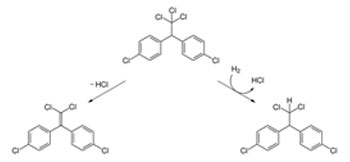 What is DDT, DDD, DDE?
What is DDT, DDD, DDE?
1,1-Dichloro-2,2-bis(p-chlorophenyl) ethylene (DDE) is a breakdown product of DDT, which was used in the past as an insecticide.
Uses
DDT was extensively used in the past for the control of malaria, typhus, and other insect-transmitted diseases. It was banned for use in the United States in 1972, except in the case of a public health emergency. DDE is a breakdown product of DDT and has no uses.
Sources & Potential Exposure
DDE is found in the environment as a result of the breakdown of DDT, an insecticide. Human exposure to DDE appears to be primarily through food; in the United States in 1981, consumption of DDE in foods was estimated to be 0.001 parts per million per day (ppm/d). However, the levels of DDE in foods have been decreasing and are expected to continue to decrease. Levels of DDE in air and water samples are very low. DDE has been listed as a pollutant of concern to EPA’s Great Waters Program due to its persistence in the environment, potential to bio accumulate, and toxicity to humans and the environment.
Federal Regulations
EPA has classified DDE as a Group B2, probable human carcinogen.

 Americas
Americas Europe
Europe Français
Français Deutsch
Deutsch Italiano
Italiano Español
Español



